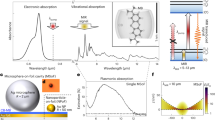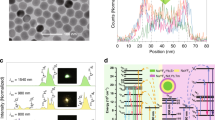Abstract
Spectral conversion of mid-infrared (MIR) radiation to visible (VIS) and near-infrared (NIR) wavelengths is a fundamental technology for spectroscopy and imaging; however, current MIR-to-VIS/NIR conversion technology is limited to nonlinear optics with bulky crystals or resonant nanocavities. Here we report lanthanide-based MIR-to-NIR nanotransducers that enable broadband MIR sensing at room temperature by harnessing ratiometric luminescence changes. The ratiometric luminescence of lanthanide nanotransducers in the NIR region can be incoherently modulated by MIR radiation in the 4.5–10.8 µm wavelength range. Ratiometric modulation of luminescence enables a detection limit of ~0.3 nW × µm−2 with an internal quantum efficiency on the order of 3 × 10−3. The ratiometric sensor based on lanthanide nanotransducers does not require cryogenic cooling, polarization control, phase matching or nanoantenna design for light confinement. We also developed a camera with lanthanide nanotransducers, which enable room-temperature MIR imaging. We anticipate that these lanthanide nanotransducers can be extended to MIR light manipulation at the microscale for chip-integrated device applications.
This is a preview of subscription content, access via your institution
Access options
Access Nature and 54 other Nature Portfolio journals
Get Nature+, our best-value online-access subscription
$29.99 / 30 days
cancel any time
Subscribe to this journal
Receive 12 print issues and online access
$209.00 per year
only $17.42 per issue
Buy this article
- Purchase on Springer Link
- Instant access to full article PDF
Prices may be subject to local taxes which are calculated during checkout




Similar content being viewed by others
Data availability
All relevant data that support the findings of this work are available from the corresponding author on reasonable request. Source Data are provided with this paper.
Code availability
The Mathematica and 1stOpt-based codes for theoretical modelling and numerical simulations are available from the corresponding author on reasonable request.
References
Waynant, R. W., Ilev, I. K. & Gannot, I. Mid-infrared laser applications in medicine and biology. Philos. Trans. R. Soc. A 359, 635–644 (2001).
Ouzounov, D. & Freund, F. Mid-infrared emission prior to strong earthquakes analyzed by remote sensing data. Adv. Space Res. 33, 268–273 (2004).
Tittel, F. K. et al. in Terahertz and Mid Infrared Radiation: Detection of Explosives and CBRN (Using Terahertz) 153–165 (Springer, 2014).
Ring, E. Beyond human vision: the development and applications of infrared thermal imaging. Imaging Sci. J. 58, 254–260 (2010).
de Cumis, M. S. et al. Widely-tunable mid-infrared fiber-coupled quartz-enhanced photoacoustic sensor for environmental monitoring. Opt. Express 22, 28222–28231 (2014).
Du, Z., Zhang, S., Li, J., Gao, N. & Tong, K. Mid-infrared tunable laser-based broadband fingerprint absorption spectroscopy for trace gas sensing: a review. Appl. Sci. 9, 338 (2019).
Roellig, T. L. et al. Mid-infrared detector development for the Origins Space Telescope. J. Astron. Telesc. Instrum. Syst. 6, 041503 (2020).
Rogalski, A. Infrared detectors: an overview. Infrared Phys. Technol. 43, 187–210 (2002).
Stuart, B. H. Infrared Spectroscopy: Fundamentals and Applications (Wiley, 2004).
Temporão, G. et al. Mid-infrared single-photon counting. Opt. Lett. 31, 1094–1096 (2006).
Dam, J. S., Tidemand-Lichtenberg, P. & Pedersen, C. Room-temperature mid-infrared single-photon spectral imaging. Nat. Photon. 6, 788–793 (2012).
Tseng, Y.-P., Pedersen, C. & Tidemand-Lichtenberg, P. Upconversion detection of long-wave infrared radiation from a quantum cascade laser. Opt. Mater. Express 8, 1313–1321 (2018).
Ashik, A. et al. Mid-infrared upconversion imaging using femtosecond pulses. Photon. Res. 7, 783–791 (2019).
Mancinelli, M. et al. Mid-infrared coincidence measurements on twin photons at room temperature. Nat. Commun. 8, 1–8 (2017).
Chen, W. et al. Continuous-wave frequency upconversion with a molecular optomechanical nanocavity. Science 374, 1264–1267 (2021).
Xomalis, A. et al. Detecting mid-infrared light by molecular frequency upconversion in dual-wavelength nanoantennas. Science 374, 1268–1271 (2021).
Wegh, R. T., Donker, H., Oskam, K. D. & Meijerink, A. Visible quantum cutting in LiGdF4:Eu3+ through downconversion. Science 283, 663–666 (1999).
Liu, Y. et al. Amplified stimulated emission in upconversion nanoparticles for super-resolution nanoscopy. Nature 543, 229–233 (2017).
Lee, C. et al. Giant nonlinear optical responses from photon-avalanching nanoparticles. Nature 589, 230–235 (2021).
Fernandez-Bravo, A. et al. Continuous-wave upconverting nanoparticle microlasers. Nat. Nanotechnol. 13, 572–577 (2018).
Liang, L. et al. Continuous-wave near-infrared stimulated-emission depletion microscopy using downshifting lanthanide nanoparticles. Nat. Nanotechnol. 16, 975–980 (2021).
Chen, S. et al. Near-infrared deep brain stimulation via upconversion nanoparticle-mediated optogenetics. Science 359, 679–684 (2018).
Bünzli, J.-C. G. & Piguet, C. Taking advantage of luminescent lanthanide ions. Chem. Soc. Rev. 34, 1048–1077 (2005).
Malta, O. L. & Carlos, L. D. Intensities of 4f–4f transitions in glass materials. Quim. Nova 26, 889–895 (2003).
Walsh, B. M., Lee, H. R. & Barnes, N. P. Mid infrared lasers for remote sensing applications. J. Lumin. 169, 400–405 (2016).
Cadatal-Raduban, M. et al. Mid-infrared imaging through up-conversion luminescence in trivalent lanthanide ion-doped self-organizing optical fiber array crystal. Opt. Lett. 46, 941–944 (2021).
Park, S.-H., Kwon, N., Lee, J.-H., Yoon, J. & Shin, I. Synthetic ratiometric fluorescent probes for detection of ions. Chem. Soc. Rev. 49, 143–179 (2020).
Smentek, L. Theoretical description of the spectroscopic properties of rare earth ions in crystals. Phys. Rep. 297, 155–237 (1998).
Dorenbos, P. The 4fn ↔ 4fn−1 5d transitions of the trivalent lanthanides in halogenides and chalcogenides. J. Lumin. 91, 91–106 (2000).
Danielmeyer, H., Blätte, M. & Balmer, P. Fluorescence quenching in Nd:YAG. Appl. Phys. 1, 269–274 (1973).
Chen, G. et al. Core/shell NaGdF4:Nd3+/NaGdF4 nanocrystals with efficient near-infrared to near-infrared downconversion photoluminescence for bioimaging applications. ACS Nano 6, 2969–2977 (2012).
Gordon, I. E. et al. The HITRAN2020 molecular spectroscopic database. J. Quant. Spectrosc. Radiat. Transf. 277, 107949 (2022).
Dam, J. S., Pedersen, C. & Tidemand-Lichtenberg, P. High-resolution two-dimensional image upconversion of incoherent light. Opt. Lett. 35, 3796–3798 (2010).
Dong, H., Sun, L.-D. & Yan, C.-H. Energy transfer in lanthanide upconversion studies for extended optical applications. Chem. Soc. Rev. 44, 1608–1634 (2015).
Liu, H. et al. Tunable resonator‐upconverted emission (TRUE) color printing and applications in optical security. Adv. Mater. 31, 1807900 (2019).
Wang, F. et al. Simultaneous phase and size control of upconversion nanocrystals through lanthanide doping. Nature 463, 1061–1065 (2010).
Tian, J. et al. Intracellular adenosine triphosphate deprivation through lanthanide-doped nanoparticles. J. Am. Chem. Soc. 137, 6550–6558 (2015).
Wolfram Research, Inc., Mathematica, Version 13.1, Champaign, IL (2022).
Acknowledgements
This work was supported by the Singapore Ministry of Education (grant nos. MOE2017-T2-2-110 and MOE2016-T3-1-006(S)), the Agency for Science, Technology and Research (A*STAR) (grant nos. A1983c0038 and A2090b0144), and National Research Foundation, Prime Minister’s Office, Singapore (award nos. NRF-NRFI05-2019-003, NRF-CRP18-2017-02, NRF-CRP22-2019-0002 and NRF-CRP19-2017-01).
Author information
Authors and Affiliations
Contributions
L.L. and X.L. conceived the idea. X.L. and Q.J.W. supervised the project and led the collaborative efforts. L.L. designed the nanotransducers and conducted numerical simulations with contributions from J.C. L.L. and C.W. conducted optical experiments. L.L., C.W. and X.L. wrote the manuscript. All authors participated in the discussion and analysis of the manuscript.
Corresponding authors
Ethics declarations
Competing interests
The authors declare no competing interests.
Peer review
Peer review information
Nature Nanotechnology thanks Guanying Chen, Dayong Jin and the other, anonymous, reviewer(s) for their contribution to the peer review of this work.
Additional information
Publisher’s note Springer Nature remains neutral with regard to jurisdictional claims in published maps and institutional affiliations.
Supplementary information
Supplementary Information
Supplementary Figs. 1–8 and Table 1.
Source data
Source Data Fig. 2
Source Data for Fig. 2b,c.
Source Data Fig. 3
Source Data for Fig. 3.
Source Data Fig. 4
Source Data for Fig. 4a,b.
Rights and permissions
About this article
Cite this article
Liang, L., Wang, C., Chen, J. et al. Incoherent broadband mid-infrared detection with lanthanide nanotransducers. Nat. Photon. 16, 712–717 (2022). https://doi.org/10.1038/s41566-022-01042-7
Received:
Accepted:
Published:
Issue Date:
DOI: https://doi.org/10.1038/s41566-022-01042-7
This article is cited by
-
A local water molecular-heating strategy for near-infrared long-lifetime imaging-guided photothermal therapy of glioblastoma
Nature Communications (2023)
-
Single-molecule mid-infrared spectroscopy and detection through vibrationally assisted luminescence
Nature Photonics (2023)
-
Mastering lanthanide energy states for next-gen photonic innovation
Science China Chemistry (2023)



